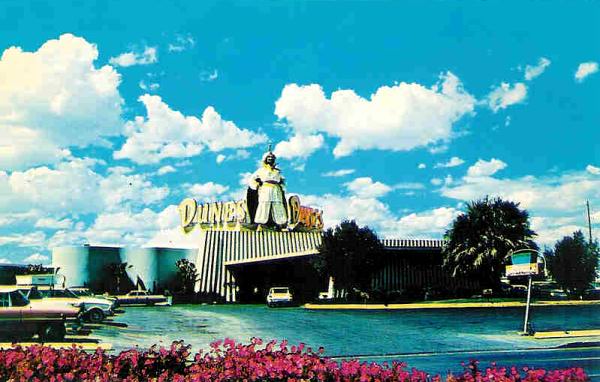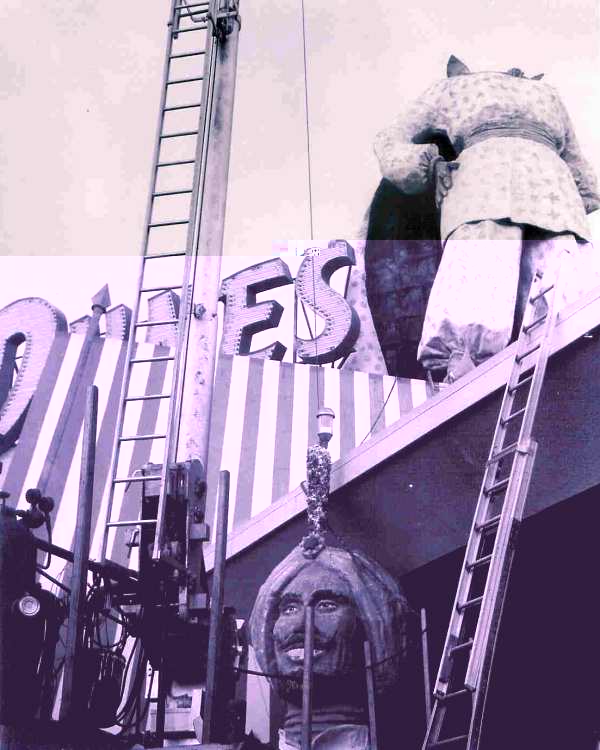
Photo from the Mark Englebretson Collection

Photo from the Rick Olsen Collection
| Dunes Hotel |
| 3650 Las Vegas Blvd South |
| 1955 - 1993 |
 Photo from the Mark Englebretson Collection |
 Photo from the Rick Olsen Collection |
The Dunes The tenth resort on the Strip…"The Miracle in the Desert" He was huge…the 30 foot tall fiberglass Sultan that overlooked the entrance to the Dunes. He was the lord of all he surveyed, a benevolent ruler; he welcomed all to his domain. Once inside, however, you were under the watchful eye of lady luck. You couldn't see her, but she was there. If she was in a good mood, you were lucky and could walk out the door as a winner, but she could turn quickly and if she weren't on your side, you would lose. In the beginning The original partners in the Dunes were Alfred Gottesman, a former movie theater chain owner; Bob Rice, a Beverly Hills costume jewelry maker; and Joe Sullivan, a Rhode Island businessman. Sullivan was rumored to be a "front man" for Ray Patriarca, head of a Rhode Island crime family. The partners bought 85 acres on the southwestern corner of Flamingo Road and the Strip, and the 200 room Dunes hotel was constructed at a cost of $3.5 million, by the McNeil Construction Company of Los Angeles. The Dunes opened on May 23, 1955, at 3650 Las Vegas Boulevard South, with great fanfare. The headliner was Vera Ellen, who starred in the musical-variety show Magic Carpet Revue, with a cast of 60 entertainers, in the Arabian Room. Ellen was a singer, dancer and actress, who had starred the previous year in Irving Berlin's White Christmas, along with Danny Kaye, Bing Crosby and Rosemary Clooney (sorry…had to throw that in, it's one of my very favorite Christmas movies!). Tough times The country was in a recession in 1955, and the Las Vegas casinos felt the pinch, especially the new casinos. The Riviera and Royal Nevada had only been open for about a month when the Dunes opened. The off-strip Moulin Rouge opened just a few days later. Without an established clientele, all four struggled. Before long, Jake Freedman, owner of the Sands, bought the Dunes. He used the experienced staff of the Sands to operate the Dunes, but it wasn't enough. Within a year the Dunes casino closed, but the low-rise hotel remained open. A new beginning In 1956 James "Jake" Gottlieb bought the Dunes, with financing from the Teamsters Union pension fund. Gottlieb brought in Major Arteburn Riddle, to assist in running the resort (Major was his name, not a rank). On June 6, 1956, the Dunes had a grand re-opening, inviting most of the residents of Clark County to attend. Over 6,700 people attended, enjoying the free buffet and dancing that were offered. Riddle had innovative ideas that worked well in Las Vegas. He booked Minsky's Follies, starring Lou Costello, for a six-week engagement. The Follies featured the first bare-breasted showgirls in Las Vegas, which caused an uproar in some circles. The controversy created publicity, the publicity generated ticket sales (a record 16,000 in one week), the business that was generated helped the resort to be profitable…and a six-week engagement lasted for well over four years. After the Follies, the showroom was used for Casino de Paris, which was conceived, produced and directed by Frederic Apcar. The show was the first to be imported from France, with its original cast. Casino de Paris played at the Dunes for over 20 years. A couple of other entertainment features included Tanya, the elephant, who pulled the handle on her own slot machine (she needed human help to feed the coins into the slot), and poolside fireworks at 10:15 every night for the entire summer, in 1960. The Sultan's Table In addition to a new direction for the entertainment, Riddle brought gourmet dining to Las Vegas in the Sultan's Table Restaurant. Some of the hors d'oeuvres offered were Terrine de Foie Gras aux Truffles for $6.75, Escargots de Bourgogne for $4.00 or Smoked Nova Scotia Salmon for $3.75. Lobster Bisque or French Onion Soup Gratinée were available for $1.85 each. A few of the entrée choices were Paupiette of Filet of Sole Marguery, Long Island Duckling à l'Orange, Prime Filet Mignon aux Champignons or Medallion of Veal à la Sultan, at prices that ranged from $9.50 to $17.00. Of course the captains were available to assist you in selecting fine wines to complement your meal. One of the captains listed was early club member and chip manufacturer, Bill Borland. Reviewed by the Diner's Club, the Sultan's Table was named "America's finest and most beautiful new restaurant." In December of 1965, the Sultan's Table was the only Las Vegas restaurant named on Esquire Magazine's "Gourmet Feast" list. Of course a buffet was also available, in the Aladdin Room, and it offered more than 50 cold and hot dishes…something for every taste. And more… In 1961 Riddle bought a huge rectangular piece of land that stretched between Dunes Road and Tropicana Avenue. He used the property to build an 18-hole, par 72 golf course. His next move was to have the Olympic Tower constructed, adding another 250 rooms to the hotel. By this time, Riddle had bought the Dunes from Jake Gottlieb. In 1965, Riddle added the "Diamond of the Dunes" tower, which brought the total number of rooms to over 1000. The tower was advertised as having 24-stories, but I've read that it actually only had 21, as the 11th, 12th and 13th floors were omitted. In spite of that, it was the tallest building in the state. Also added was the 180 foot "Diamond of the Dunes" sign. At the time, it was the largest freestanding sign in the world. Including the foundation, the sign weighed 1,500,000 pounds. The sign had miles of neon tubing, used 10,000 lighting units, and had an annual operating cost of $47,500. In June of 1965 the "Dome of the Sea" seafood restaurant opened. There was a pool in the center of the restaurant. In the pool was an "island" where a harp player would sit, playing for the enjoyment of the diners. Two of the harpists were Barbara Allen and Kippy Lou Brinkman. Is Friday the 13th an unlucky day, or a lucky day? In October of 1967 it was both, for the Dunes. There was a hot hand at the dice table…50 straight passes that cost the Dunes $250,000. Sounds unlucky, BUT…they got worldwide publicity that they couldn't have bought for any price. In 1970, billionaire Howard Hughes considered buying the Dunes, but the Gaming Control Board was not willing to issue any more gaming licenses to Hughes, fearing violation of anti-trust laws. In December of 1979 the Dunes opened another tower, adding another 300 rooms to the count. The new tower advertised luxurious suites with multi-level layouts, exotic flora and cascading waterfalls. The Dunes offered acres of free parking, two giant swimming pools (the Seahorse Pool and the Olympic Pool), the largest golf course in the state, a convention center, conference rooms and a staff of more than 2,300. The 1960's and 1970's had been good. In 1983 the Oasis Casino was added to the property. During one of the renovations, the Sultan had been moved to the golf course, where he was visible to traffic passing on the highway. In 1985 an electrical short in his stomach caused him to catch fire, he was destroyed. The 1980's were tough on the Dunes. She was getting older, and was sold a couple of times. In 1987 she was sold to Japanese millionaire investor Masao Nangaku for $155 million. Her new owners weren't able to make the aging property a success, especially as new mega-resorts were opening and providing added competition, starting with the Mirage. It took about 10 years for the Dunes to go from being one of the showplaces on the strip to being a run down high-rise. Steve Wynn In 1992 Steve Wynn bought the Dunes for $75 million. At midnight, January 26, 1993, the Dunes closed and the employees were offered a last (free) prime rib dinner in the Sultan's Table Restaurant. On September 26, 1993, a four-alarm fire started at the Dunes when a construction (destruction?) worker drove a front-end loader over an electrical circuit. Winds of 30 miles per hour fanned the flames, and blew burning embers over the Strip. Caesars Palace turned on their sprinklers to put out any embers that blew their way. Barbary Coast and the Flamingo Hilton were advised to turn off their ventilation systems to avoid drawing smoke into the rooms. Because there were no lives in jeopardy (all construction workers had been accounted for), and the property was scheduled for destruction anyway, the fire fighting was aimed at preventing damage to other properties. The fire was contained by 7:00 p.m. On October 27, 1993, from the front of his new Treasure Island Resort, Steve Wynn "fired" a cannon that was aimed at the Dunes. The Dunes casino, sign and north tower were imploded at that moment. It took 365 pounds of dynamite, placed into 426 strategically placed drill-holes, 84 flash-bombs and 281 fire mortars to bring the Dunes down, with the desired effects. The south tower was used, for a time, to house the records of the Mirage and Treasure Island properties. In 1994 the south tower, too, was imploded, but without fanfare. The Bellagio On October 15, 1998, on the site of the Dunes, The Bellagio opened. It's 36 stories contained 3,026 rooms and suites, and it was built at a cost of $1.6 billion. The property holds Lake Como, which has more than a thousand fountains and runs the length of the Bellagio property. At regularly scheduled times the fountains "dance" to amplified music, to the delight of crowds that gather on the Strip to watch. There is a 12,500 square foot conservatory that has beautifully designed botanical displays. The displays are changed every season. The lobby ceiling contains a 66' x 30' display of approximately 2000 Dale Chihuly floral pieces, of mouth-blown multi-colored glass. The glass weighs approximately 40,000 pounds. The casino is 156,000 square feet; it holds 173 table games and over 2,700 machines. First published in the Casino Chip and Token News Magazine Spring 2008, Volume 21 number 1 issue. Casino Chip and Tokens News is the official publication of The Casino Chip and Gaming Token Collectors Club, Inc. Special Permission was granted to reprint this information. All rights are reserved by the CCGTCC. If interested in joining this fascinating collecting field and receiving the clubs award winning magazine, go to www.ccgtcc.com and select membership. |